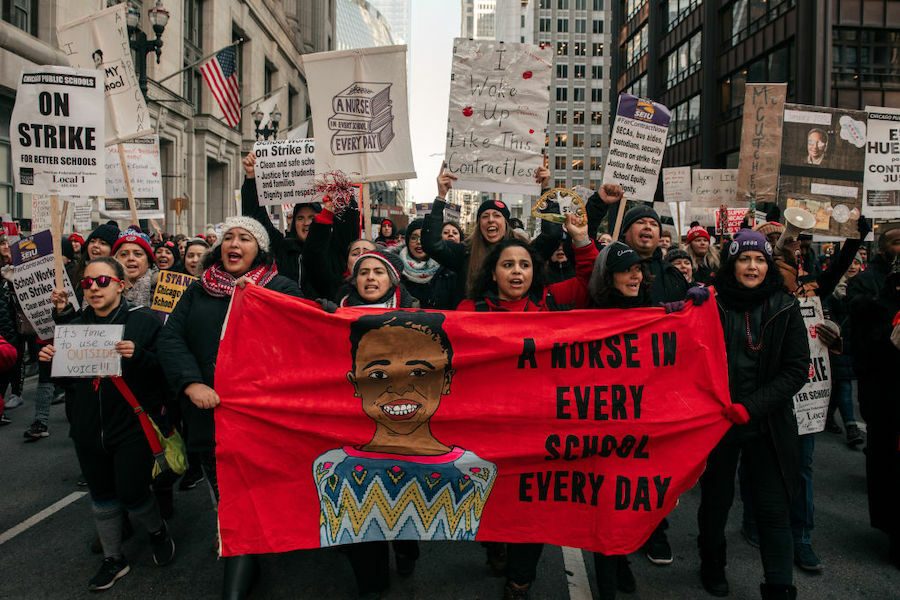Labor Needs To Embrace Social Justice Unionism
A successful rank-and-file strategy must look beyond the workplace.
Bill Fletcher, Jr.

Proponents of the “rank-and-file strategy” (RFS) emphasize the need to lay the foundations of a revitalized labor movement through rank-and-file workers — as opposed to union staff or leadership. As Laura Gabby notes, this idea has a long history: In the 1970s, for instance, thousands of leftists (myself included) of both working-class origin and otherwise entered the workforce to build a real working-class Left and rebuild organized labor.
Though this rank-and-file emphasis is more of an orientation than a full strategy, it is good in that it encourages people on the Left to engage as rank and filers — to enter into the working class as coworkers rather than staff. The idea is not, as Andrew Dobbyn argues, elitist; instead, it suggests fellow workers have something to teach, rather than simply being vessels for knowledge from leftists.
But the current discussion has certain important blind spots. First, the mostly white socialists discussing the RFS often fail to recognize that leftist formations composed mostly or entirely of people of color have historically been instrumental in developing and leading efforts to retool the labor movement. The direction and character of these formations has frequently differed from that of white-led formations.
Peter Shapiro presents one example in his Jacobin article, “On the Clock and Off,” drawing on his work with the League of Revolutionary Struggle. He writes about the Mexican immigrant women who emerged as rank-and-file leaders in the 1985 – 87 frozen food strike in Watsonville, Calif. They were not part of their union’s progressive reform caucus, the Teamsters for a Democratic Union, nor would they have been considered part of any conventional “militant minority” — which is why, Shapiro writes, “some strike supporters on the Left viewed them skeptically.” But these women established their own informal infrastructure, bound together through the solidarity of not just working together but the shared experience of racial and gender oppression, and propelled the strike to victory.
More broadly, proponents of the rank-and-file strategy must look beyond the clear, identifiable base of organic leaders and leftists and assess the forces within any workplace, including conservatives and pragmatists. As Fernando Gapasin and I write in our book, Solidarity Divided, to defeat the conservative elements, the Left must pull the center along. Advocates of a “militant minority” can be skeptical of such alliances, but this is a mistake.
William Z. Foster, a brilliant trade unionist who led the Communist Party USA, advocated a militant minority strategy but later adjusted his approach to pursue a “Left-Center Alliance,” recognizing that, even in the militant 1930s, the Left was not sufficiently powerful to act alone. Workers will not necessarily agree with the total program of a leftist, so it is unlikely that leftists will be organizing workers around an exclusively left-wing program. To the extent to which we ignore the center we cede territory to conservative forces that will build their own alliances to crush the Left.
Leftists in the labor movement must also look beyond the narrow objectives of trade unionism as we know it, centered on making gains within the workplace. In fact, the Left needs an alternative framework, a “social justice unionism,” with objectives focused on the larger working class — which includes, for instance, what Stephen Lerner and others refer to as “bargaining for the common good.” Here, the union takes issues of the larger community to the bargaining table. Unions, too, might provide active support to or establish shared agendas with other worker or progressive community organizations.
Lastly, rebuilding the labor movement requires recognition that labor, as Andrew points out, is not only trade unions. The rise of so-called alt-labor, such as worker centers and domestic worker organizations, is part of this rebuilding. Leftists play a major role in this sector, which is disproportionately workers of color. Unions can and should provide direct material assistance to this organizing; the Zimbabwe Congress of Trade Unions, for instance, has worked to ally with informal economy workers.
A Left without a working class base is not a Left, but a collection of advocates for change. Our mission is to rebuild that base, transforming the Left and the labor movement together.
For alternate perspectives on the rank-and-file strategy, see “Want To Build the Labor Movement? Get a Job at a Union Workplace.”and “90% of Workers Aren’t in a Union. Labor’s Future Depends on Them.”
Bill Fletcher, Jr. is a talk show host, writer, activist, and trade unionist. The Man Who Changed Colors is his latest novel. His first novel is The Man Who Fell From the Sky. He is also co-author (with Fernando Gapasin) of Solitary Divided, and the author of “They’re Bankrupting Us” — Twenty Other Myths about Unions. You can follow him on Twitter, Facebook and at www.billfletcherjr.com.









